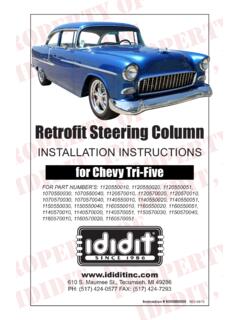Transcription of HORN OPERATION DIAGNOSIS – MOST GM VEHICLES …
1 1 Revised: 27OC2010 horn OPERATION DIAGNOSIS most GM VEHICLES 1967 AND UP All General Motors VEHICLES (from the 60s through the 80s) have a horn or horns that operate on the same basic principle. When you press on the steering wheel horn cap, horn button, or pad you complete a circuit to ground through the steering column and closing this circuit actuates a relay. The horns are wired directly to ground and are connected to a 12 volt source when the relay is actuated. There are three basic areas that can cause your horns not to operate correctly: 1) the horns themselves; 2) the horn relay/key buzzer; 3) the horn circuit in the steering column and steering wheel parts. The following are step by step procedures to diagnose a horn problem. 1). Horns - There are two horns on most GM VEHICLES . There is a dark green or black 14 gage wire connected to them from the #3 terminal on the horn relay.
2 Disconnect this wire from the horns and connect a 12v source to them; they should operate. If they don t, check that they are properly grounded. Check for corrosion where the horns and/or wires are connected to the body or frame structure. Otherwise, the horns need to be repaired or replaced. 2). horn Relay/Key Buzzer In general, most 1967-68 VEHICLES have the horn relay mounted somewhere in the engine compartment. Later models have the horn relay mounted inside the car, under the dash on the instrument panel wiring harness coming out of the fuse panel. Although the terminal type and location may vary between models, the numerical designation on the relay is standardized. Starting the 1968 model year, the ignition key warning buzzer was incorporated into the relay. 2 Remove the relay from its mounting and identify the #2 and #3 terminals.
3 Connect a jumper from the terminal marked #2 to ground. Slide a probe into the wiring harness connector to make contact if the terminals are the slip-on type. If the horns operate, check the #2 terminal wire and horn switch for defects. If the horns do not operate, leave the #2 terminal connected to ground, and connect a voltmeter from the #3 terminal to ground. If a reading is obtained, check the horn wiring and horns for defects. If no reading is obtained, replace the horn relay/buzzer. 3). steering Column and steering Wheel Circuit - The turn signal switch wiring that is part of the 1967-68 steering column has a curved electrical connector that connects to the vehicle wiring harness. 1969 and later steering columns have turn signal switch wiring connectors that are a different design. They are flat and shaped somewhat like a harmonica.
4 All of the wires from the connector extend up into the steering column and connect directly to the turn signal switch in the column head. Disconnect the turn signal switch connector from the vehicle harness. On one end of the curved connector (1967-68) there should be an empty socket. Then the last wire on that end should be black and is the horn ground wire. With the harmonica type connector (1969+) the last wire in the steering column connector is a black one. Next to it is a pink wire. The next wire (the third one) is another black wire and is the horn ground wire. When you press the horn button there should be continuity from the horn ground wire in the above connectors all the way to the lower end of the steering column steering shaft and across the flexible coupling to the flange that mounts to the steering gear input shaft.
5 If there is not continuity, the problem is somewhere within the steering column, flexible coupling, or steering wheel horn parts themselves. steering Column Wiring Disconnect the battery. On VEHICLES with a horn cap, use a small screwdriver and carefully pry on the cap where it snaps into the upper horn contact. Remove the cap from the steering wheel and then remove the three screws and the upper horn contact. Underneath the upper horn contact there should be a spring loaded plunger inside a plastic tube that extends up and through the steering wheel hub. On VEHICLES with a horn pad, remove the pad from the steering wheel and disconnect the pad wiring from the plunger. There should be continuity from the horn ground wire in the turn signal switch wiring connector up to the spring loaded plunger. If not, the problem is within the steering column itself.
6 3 Canceling Cam & Upper horn Contact On all GM steering columns (except tilt & telescoping) the plunger extending through the steering wheel hub is part of the turn signal canceling cam assembly. 4 The T&T steering column is a special case where the plunger extending through the steering column hub is part of the lower contact asm #1. The lower contact asm is attached to the hub by three screws #5 and has a big coil spring that contacts the canceling cam inside the steering column head. The plunger should rest against the underside of the upper horn contact #7. The plunger consists of a spring #2, the plunger itself (also called an eyelet) #3, and a plastic bushing (called an insulator) #4. The spring fits into the tube first, then the eyelet (upset end first) then the insulator. The insulator is either a press fit or it needs to be inserted and then rotated so that it cams into the end of the tube and retains the spring and eyelet.
7 Common Problem horn Blows Continuously or Blows Intermittently (On Its Own When Turning the steering Wheel) Both the standard columns and the tilt columns from 1967 and up have their turn signal levers attached to the steering column switch by a single screw. This screw can loosen, back out, and ground the horn circuit because it is now touching the underside of the canceling cam. You will need to remove the steering wheel and hub in order to reach the screw. On 1969 and later locking steering columns you will have to rotate the steering shaft so that a hole in the locking plate aligns with the turn signal lever screw. Retighten it. 5 Lack of Continuity From steering Column Connector to the steering Gear If you press the horn cap (or the horn pad) and there is a lack of continuity from the horn wire in the turn signal switch connector all the way to the flexible coupling flange that attaches to the gear input shaft, you need to look for missing, broken, or corroded parts.
8 Inspect the upper horn contact (the part that the horn cap connects to). It should be held together with plastic rivets and should be spring loaded internally to prevent continuity across the contact unless it is depressed. Are the rivets broken or the spring fatigued? On VEHICLES so equipped, check for continuity between the wire coming from the horn pad and the threaded metal mounting holes on the underside of the pad. Depressing the pad or pushing on the buttons on the pad should complete the circuit. Flexible Coupling Continuity Your OEM flexible coupling assembly has a ground wire or strap routed inside the rubber disc to provide an electrical grounding path from one side of the flex coupling to the other. On coupling assemblies manufactured after 1972 there is a molded metal screen in the face of the rubber coupling disc that provides the electrical grounding path from the steering column to the steering gear.
9 Some aftermarket replacement units and most flex coupling rebuild kits do not provide a ground path. This could be the reason why your horn suddenly stops working (particularly if you just serviced the flexible coupling assembly.) If your horn honks intermittently or honks on its own, you need to look for a location that is grounding incorrectly. Look for a chaffed wire extending up from the lower plastic connector up to the turn signal switch. Could that wire have a bare spot that might be rubbing against a metal column part? HornOperationDiagnosis27OC2010

